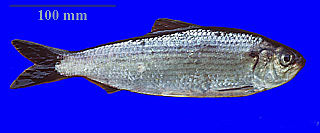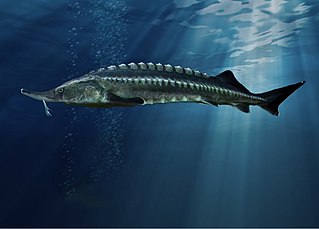
Brackish water, also sometimes termed brack water, is water occurring in a natural environment having more salinity than freshwater, but not as much as seawater. It may result from mixing seawater with fresh water together, as in estuaries, or it may occur in brackish fossil aquifers. The word comes from the Middle Dutch root "brak". Certain human activities can produce brackish water, in particular civil engineering projects such as dikes and the flooding of coastal marshland to produce brackish water pools for freshwater prawn farming. Brackish water is also the primary waste product of the salinity gradient power process. Because brackish water is hostile to the growth of most terrestrial plant species, without appropriate management it is damaging to the environment.

The alewife is an anadromous species of herring found in North America. It is one of the "typical" North American shads, attributed to the subgenus Pomolobus of the genus Alosa. As an adult it is a marine species found in the northern West Atlantic Ocean, moving into estuaries before swimming upstream to breed in freshwater habitats, but some populations live entirely in fresh water. It is best known for its invasion of the Great Lakes by using the Welland Canal to bypass Niagara Falls. Here, its population surged, peaking between the 1950s and 1980s to the detriment of many native species of fish. In an effort to control them biologically, Pacific salmon were introduced, only partially successfully. As a marine fish, the alewife is a US National Marine Fisheries Service "Species of Concern".

Alosa is a genus of fish, the river herrings, in the family Clupeidae. Along with other genera in the subfamily Alosinae, they are generally known as shads. They are distinct from other herrings by having a deeper body and spawning in rivers. Several species can be found on both sides of the Atlantic Ocean and Mediterranean Sea. Also, several taxa occur in the brackish-water Caspian Sea and the Black Sea basin. Many are found in fresh water during spawning and some are only found in landlocked fresh water.

The beluga, also known as the beluga sturgeon or great sturgeon is a species of anadromous fish in the sturgeon family (Acipenseridae) of order Acipenseriformes. It is found primarily in the Caspian and Black Sea basins, and formerly in the Adriatic Sea. Going on maximum size, it is the third most massive living species of bony fish. Heavily fished for the female's valuable roe, known as beluga caviar, wild populations have been greatly reduced by overfishing and poaching.

The allis shad is a widespread Northeast Atlantic species of fish in the herring family, Clupeidae. It is an anadromous fish which migrates into fresh water to spawn. It is found in the eastern Atlantic Ocean, the western Baltic Sea and the western Mediterranean Sea. In appearance it resembles an Atlantic herring but has a distinctive dark spot behind the gill cover and sometimes a row of up to six spots behind this. It sometimes hybridises with the twait shad. This fish becomes mature when three or more years old and migrates to estuaries, later swimming up rivers to spawn. Populations of this fish have declined due to overfishing, pollution and habitat destruction. Conservation of this species is covered by Appendix III of the Bern Convention and Appendix II and V of the European Community Habitats Directive.

The twait shad or twaite shad is a species of fish in the family Clupeidae. It is found in the eastern Atlantic Ocean and the Mediterranean Sea and is an anadromous fish which lives in the sea but migrates into fresh water to spawn. In appearance it resembles an Atlantic herring but has a row of six to ten distinctive spots on its silvery flanks. They become mature when three or more years old and migrate to estuaries, later swimming up rivers to spawn. Populations of this fish have declined due to overfishing, pollution and habitat destruction. Conservation of this species is covered by Appendix III of the Bern Convention and Appendix II and V of the European Community Habitats Directive.
Alosa macedonica, or the Macedonian shad, is a landlocked species of clupeid fish endemic to Greece. Its single natural occurrence is the freshwater Lake Volvi in northern Greece. It is threatened by habitat loss.

Alosa maeotica, known as the Black Sea shad or Azov shad, is a species of clupeid fish endemic to the Sea of Azov and the western part of the Black Sea basin. It is found in Bulgaria, Georgia, Moldova, Romania, Russia, Turkey, and Ukraine.
Alosa vistonica is a species of shad, a freshwater fish in the family Clupeidae. It is endemic to a single shallow lake, Lake Vistonida in Greece. It is classified as critically endangered (CR) and is threatened by sewage, industrial effluents, destruction of spawning sites by agricultural development and increased salinity following the opening of a canal into the sea. It has been suspected to be extinct already.

The Caspian Sea is the world's largest inland body of water, variously classed as the world's largest lake or a full-fledged sea. An endorheic basin, it lies between Europe and Asia; east of the Caucasus, west of the broad steppe of Central Asia, south of the fertile plains of Southern Russia in Eastern Europe, and north of the mountainous Iranian Plateau of Western Asia. It covers 371,000 km2 (143,000 sq mi) and a volume of 78,200 km3 (19,000 cu mi). It has a salinity of approximately 1.2%, about a third that of average seawater. It is bounded by Kazakhstan from mid-north to mid-east, Russia from mid-north to mid-west, Azerbaijan to the southwest, Iran to the south and adjacent corners, and Turkmenistan along southern parts of its eastern coast.

Alosa caspia is a species of clupeid fish, one of the species of shad endemic to the Caspian Sea basin.

Alosa braschnikowi, the Caspian marine shad or Brazhnikov's shad, is one of the clupeid fish species endemic to the Caspian Sea.

The Pontic shad, also referred to as the Black Sea shad or Kerch shad, is a species of clupeid fish in the genus Alosa, native to the Black Sea and Sea of Azov basins.
Alosa kessleri, also referred to as the Caspian anadromous shad, the blackback, or the black-spined herring, is a species of clupeid fish. It is one of the several species of shad endemic to the Caspian Sea basin.
Alosa sphaerocephala, or the Agrakhan shad, is a species of clupeid (herring-like) fish, one of the endemic shad species in the Caspian Sea.

Alosa tanaica, called in English the Azov shad or Black Sea shad, is a species of clupeid fish endemic to the Ponto-Caspian basin. It is an anadromous species, spawning in the lower reaches of rivers. It is widespread in the eastern Black Sea, the Kerch Strait and the Sea of Azov.
Alosa volgensis, the Volga shad, is a clupeid fish, one of the species of shad endemic to the Caspian Sea region.

The tadpole-gobies (Benthophilus), also called pugolovkas, are a genus of Ponto-Caspian fishes in the family Gobiidae.

Nikolai Mikhailovich Knipovich was a Russian ichthyologist, marine zoologist and oceanographer, notable as the founder of fisheries research in the Russian North.
Alosa curensis, the Kura shad, is one of the species of clupeid fish endemic to the Caspian Sea basin. It is found in the southwestern part of the brackish sea-lake, near the mouth of the Kura River, Azerbaijan. But generally this is a poorly known species.













